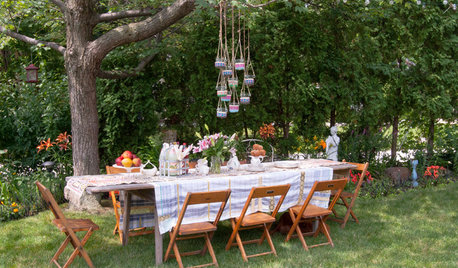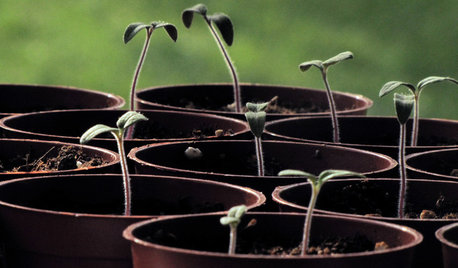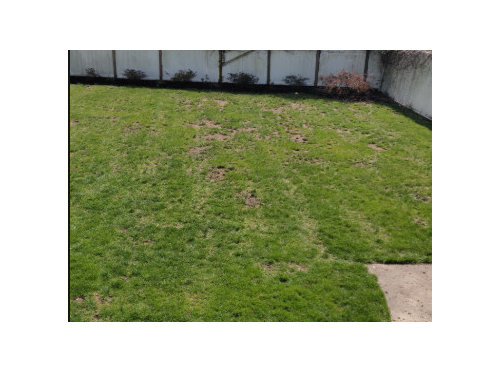Should I re-seed and fix or hold off?
mahtab93
4 years ago
Featured Answer
Sort by:Oldest
Comments (42)
morpheuspa (6B/7A, E. PA)
4 years agomahtab93
4 years agoRelated Discussions
I should be happy they're cleaning the yard up, but...
Comments (5)Oh, do I understand! The house across the street was purchased three years ago by NJ woman who was going to retire in five years. She gets down here twice a year. The front yard is beach grass and weeds--the St. Augustine died a couple of years ago. She doesn't fertilizer the lawn because she doesn't have to do that in NJ. The sprinkler system quits when the electricity goes off. She removed a 7 year old orange and a matching lemon tree--they had thorns. They looked bad because they had never been fertilized and didn't get watered regularly. She cut back three red bay trees to 5-ft trunks and then applied to the city to remove them because they died. Her place looks neglected and unloved and the house needs paint. She just doesn't see it! Yards bordering her are well maintained. My yard across from her is also well maintained. She just doesn't care! I dread the day she moves here permanently!...See MoreShould i hold off on water?
Comments (5)I am nearing some sort of step in this direction also, Kenny. I've used the withholding water trick at the end of the season to hurry up ripening and suppress continued growth. As we are approaching 1st frost, that works well - as long as we don't get a good rainstorm. I suppose it might prompt flowering but I'm reluctant to use the technique at this time of year. Still, the plants have few blooms & I'm getting worried. With 20+ varieties, they are varied in growth, appearance and what I expect out of them but almost without exception: there is little to no green fruit or blossoms. The exceptions are Thessaloniki - & I'm not sure why those plants are so small this time having opted for loading up with fruit, I guess - and the mystery tomato I was going on so much about in 2011. (The seed contaminated a packet of Early Girl seed.) The mystery tomatoes, however, are the only ones out of 60+ plants where I'm finding some kind of foliage problems. The only ripe tomato has come from 1 of those plants and there are more in the offing! Still, I'm not happy about a repeat of the problem these things had in 2011. I sprayed Miracle Gro bloom booster on the flower garden this year. It made an obvious difference in the strength of the snapdragon stems which have broken in strong winds, some years. Not this time . . . colors are nice, also. Synthetic fertilizers haven't been in my veggie gardens in over a dozen years. Maybe I'll stop at the garden center tomorrow & see if they have this liquid bonemeal Jay talks about. The tomato plants look really great out there and it would be a shame if they set a crop too late. Shame? It would be a tragedy!! Good hot July here with 9 days above 90F so far. I know that doesn't compare with what most of the country is experiencing but it is quite a turnaround from Junuary. Steve...See MoreAm I being silly, or should the electrician fix this?
Comments (9)Thanks all. The pipe on the sink wall couldn't move short of pretty major structural work, unfortunately---it's the vent pipe and it's running up a load-bearing wall that is not open, so opening it would have triggered another level of permits (right now our building permit is just for non-structural modifications and walls)---so those outlets had to stay put. I'm actually fine with that, though, they'll be three inches off the counter, which seems fine---actually a bit higher than where the vertical outlets were in the old kitchen, since they had the same constraint. The new outlets they put in are, I think, 42 inches to center---the sink wall outlets are 40 inches to center. So we could probably get close by just putting them horizontally at the bottom of the existing opening. This wall has no sink or stove, though, so it's unfortunately the one spot where there's no splashing or other danger to low outlets....ah, well. They will be for the toaster oven, mixer, and other tall things, though, so they'll likely be pretty hidden regardless. The main reason to leave them alone, from DH's perspective, is just that he wants the work finished already. (We are playing GC for this ourselves, so one of us has to work at home whenever contractors are here---thus it would be nice to be done so we can move on to the next contractor!) @hydrangea_luvr, wish I had some progress pictures (or some progress!!) I took a few the day of demo, but am hoping to take another round next week if the electrician really can wrap this up so we can have our rough inspections. (He'd better, since then the plaster crew comes in to patch the plaster so we can paint the room over Thanksgiving weekend.) I have a feeling it will suddenly start to come together once the plaster goes up and it feels like a room again....See MoreBotched Tile: how should I ask contractor to fix this mistake?
Comments (6)Hi Patricia and thank you for your comment. However, I did not post on the same subject. My other question is separate as I indicated in this post. If you'd like to check out the other post I welcome your feedback on that grout issue as well. And, as I said, we've been happy with our contractors work overall. That's why discovering this mistake and his lack of communication about it surprised us so much. 90% of the job is done and done well, so I'm not too concerned about that. I know he'll come for his last check, and I expect that he will fix it per what we request. I am seeking advice on exactly what to ask him to do from those with tiling/tile-fixing experience. Replace the whole tile on each piece that is chipped/or has the accidental hole? Or, is there an acceptable enamel-type fix anyone would recommend? I am the painter on this project and 2 of these tiles are next to the ceiling. I'm worried about damage to the new drywall, ceiling, and time I don't have to paint again as hubby and I are working full time during this closure. So, rather than flippant calls for shame, why not thoughtful ones about what to ask my contractor to do?...See Moremorpheuspa (6B/7A, E. PA)
4 years agomahtab93
4 years agolast modified: 4 years agorifis (zone 6b-7a NJ)
4 years agorifis (zone 6b-7a NJ)
4 years agomorpheuspa (6B/7A, E. PA)
4 years agodchall_san_antonio
4 years agomorpheuspa (6B/7A, E. PA)
4 years agomahtab93
4 years agodchall_san_antonio
4 years agomorpheuspa (6B/7A, E. PA)
4 years agolast modified: 4 years agorifis (zone 6b-7a NJ)
4 years agorifis (zone 6b-7a NJ)
4 years agomorpheuspa (6B/7A, E. PA)
4 years agomahtab93
4 years agodchall_san_antonio
4 years agomorpheuspa (6B/7A, E. PA)
4 years agomahtab93
4 years agodchall_san_antonio
4 years agorifis (zone 6b-7a NJ)
4 years agomorpheuspa (6B/7A, E. PA)
4 years agolast modified: 4 years agomahtab93
4 years agomorpheuspa (6B/7A, E. PA)
4 years agomahtab93
3 years agomorpheuspa (6B/7A, E. PA)
3 years agomahtab93
3 years agomorpheuspa (6B/7A, E. PA)
3 years agomahtab93
3 years agomorpheuspa (6B/7A, E. PA)
3 years agomahtab93
3 years agomorpheuspa (6B/7A, E. PA)
3 years agomahtab93
3 years agomorpheuspa (6B/7A, E. PA)
3 years agolast modified: 3 years agomahtab93
3 years agoJonathan M
3 years agomorpheuspa (6B/7A, E. PA)
3 years agomahtab93
3 years agomorpheuspa (6B/7A, E. PA)
3 years agomahtab93
3 years agomorpheuspa (6B/7A, E. PA)
3 years ago
Related Stories

FUN HOUZZEverything I Need to Know About Decorating I Learned from Downton Abbey
Mind your manors with these 10 decorating tips from the PBS series, returning on January 5
Full Story
LIFEHouzz Call: How Do You Hold On to Summer at Home?
Summer is winding down, but it’s not over yet! If you're still enjoying some lazy days, we want to see how you’re making the most of them
Full Story
PRODUCT PICKSGuest Picks: Kentucky Derby Party Fixings and Decor
Get a Derby Day party off to a great start with accessories, serveware and furnishings that champion the cause of chic
Full Story
SHOP HOUZZFavorite Fixes for a Small Kitchen
Storage organizers and shelves to clear off counters
Full Story0

EDIBLE GARDENSPlanting Time: Get Your Garden Started With Seeds
You can get an early gardening fix — and save money too — by starting seedlings in the warm indoors
Full Story
HOUSEKEEPINGKitchen Fix: Where to Hang the Dish Towels
Keep these hardworking cloths handy and dry. And even find room to show off the ones that no one is allowed to use!
Full Story
LIFESlow Living 101: Tips for Turning Off the Chaos
It may feel as though you're too busy to slow down and enjoy life. But even little changes can have a big effect
Full Story
REMODELING GUIDESFinish Your Remodel Right: 10 Tasks to Check Off
Nail down these key details to ensure that everything works properly and you’re all set for the future
Full Story
LIFE10 Ways to Keep Your Home Safe While You're Traveling
Set off on your trip with peace of mind, knowing you've taken the right steps toward keeping your home secure
Full Story
FEEL-GOOD HOMEKick Off Your New Year With a ‘Get It Done’ Day
Cross a bunch of small tasks off your list — or choose just one quick-ish fix — for a feel-good start to the year
Full Story











mahtab93Original Author